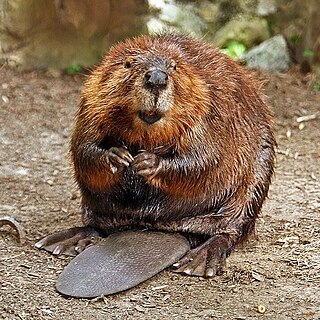
Nutria fur, also known as coypu fur, is used in the fashion industry. It comes from the nutria, a South American rodent and cousin of the beaver.

Nutria fur, also known as coypu fur, is used in the fashion industry. It comes from the nutria, a South American rodent and cousin of the beaver.
The nutria is a semi-aquatic mammal native to South America. It first became internationally popular as a fur in the 1930s, when it was worn by Hollywood stars such as Greta Garbo. [1] It resembles beaver, with stiff guard hairs and a soft, short undercoat. [2]
It was originally imported to the southern United States – possibly as early as the 19th century, although in larger numbers from the 1950s – to reduce the population of muskrat. [3] [4] Some escaped and found the swamps of Louisiana ideal territory, leading to their common name of swamp rat. With the decline in the fur market in the 1980s, the population mushroomed and threatened the stability of the wetland ecosystem by eating away the plants that hold the swamp together. [4]

Typically, nutria is sheared or plucked for the fur trade. It can be dyed a variety of colors. Its middle weight – considerably lighter than beaver – also makes it suitable for linings. More recently, it is used by some furriers without plucking or shearing. In its natural colour it is light to rich brown, the most valuable furs being in the darker shades, but it may also be dyed. [3]
A faux nutria, made of rabbit fur was at one time branded as nutriette. [5]
In 2010, both the BBC and The New York Times reported that nutria was being promoted as a socially acceptable way to wear fur, with a fashion show held in Brooklyn sponsored by the Barataria-Terrebonne National Estuary Program, a conservation body working to preserve Louisiana swampland threatened by the nutria. [1] [4]
Oscar de la Renta and Michael Kors are among the designers to have incorporated nutria into their designs, with de La Renta using it on hats and trims and Kors using it to line raincoats. [6]

Beavers are large, semiaquatic rodents of the Northern Hemisphere. There are two existing species: the North American beaver and the Eurasian beaver. Beavers are the second-largest living rodents, after capybaras, weighing up to 50 kg (110 lb). They have stout bodies with large heads, long chisel-like incisors, brown or gray fur, hand-like front feet, webbed back feet, and tails that are flat and scaly. The two species differ in skull and tail shape and fur color. Beavers can be found in a number of freshwater habitats, such as rivers, streams, lakes and ponds. They are herbivorous, consuming tree bark, aquatic plants, grasses and sedges.

Óscar Arístides Renta Fiallo, known professionally as Oscar de la Renta, was a Dominican fashion designer. Born in Santo Domingo, he was trained by Cristóbal Balenciaga and Antonio del Castillo. De la Renta became internationally known in the 1960s as one of the couturiers who dressed Jacqueline Kennedy. He worked for Lanvin and Balmain. His eponymous fashion house has boutiques around the world, and is headquartered on Madison Avenue in Manhattan.

New France was the territory colonized by France in North America, beginning with the exploration of the Gulf of Saint Lawrence by Jacques Cartier in 1534 and ending with the cession of New France to Great Britain and Spain in 1763 under the Treaty of Paris.

The nutria or coypu is a large, herbivorous, semiaquatic rodent from South America. Classified for a long time as the only member of the family Myocastoridae, Myocastor is now included within Echimyidae, the family of the spiny rats. The nutria lives in burrows alongside stretches of water and feeds on river plant stems. Originally native to subtropical and temperate South America, it has since been introduced to North America, Europe, Asia, and Africa, primarily by fur farmers. Although it is still hunted and trapped for its fur in some regions, its destructive burrowing and feeding habits often bring it into conflict with humans, and it is considered an invasive species. Nutria also transmit various diseases to humans and animals, mainly through water contamination.

The fur trade is a worldwide industry dealing in the acquisition and sale of animal fur. Since the establishment of a world fur market in the early modern period, furs of boreal, polar and cold temperate mammalian animals have been the most valued. Historically the trade stimulated the exploration and colonization of Siberia, northern North America, and the South Shetland and South Sandwich Islands.

John Charles Galliano is a British fashion designer born in Gibraltar. He was the creative director of his eponymous label John Galliano and French fashion houses Givenchy and Dior. Since 2014, Galliano has been the creative director of Paris-based fashion house Maison Margiela. Galliano has been named British Designer of the Year four times. In a 2004 poll for the BBC, he was named the fifth most influential person in British culture.

The muskrat is a medium-sized semiaquatic rodent native to North America and an introduced species in parts of Europe, Asia, and South America. The muskrat is found in wetlands over a wide range of climates and habitats. It has important effects on the ecology of wetlands, and is a resource of food and fur for humans.

The Eurasian beaver or European beaver is a species of beaver that was once widespread in Eurasia, but was hunted to near-extinction for both its fur and castoreum. At the turn of the 20th century, only about 1,200 beavers survived in eight relict populations in Europe and Asia. It has been reintroduced to much of its former range, and now occurs from Spain, Central Europe, Great Britain and Scandinavia to a few regions in China and Mongolia. It is listed as least concern on the IUCN Red List, as it recovered well in most of Europe. It is extirpated in Portugal, Moldova, and Turkey.

The North American beaver is one of two extant beaver species, along with the Eurasian beaver. It is native to North America and has been introduced in South America (Patagonia) and Europe. The North American beaver is one of the official national wildlife of Canada symbols and is the official state mammal of Oregon and New York. North American beavers are widespread across the continental United States, Canada, southern Alaska, and some parts of northern Mexico.

"Alouette" is a popular Quebecois children's song, commonly thought to be about plucking the feathers from a lark. Although it is in French, it is well known among speakers of other languages; in this respect, it is similar to "Frère Jacques". Many US Marines and other Allied soldiers learned the song while serving in France during World War I and took it home with them, passing it on to their children and grandchildren.

Rabbit hair is the fur of the common rabbit. It is most commonly used in the making of fur hats and coats, and is considered quite valuable today, although it was once a lower-priced commodity in the fur trade.

Fur clothing is clothing made from the preserved skins of mammals. Fur is one of the oldest forms of clothing and is thought to have been widely used by people for at least 120,000 years. The term 'fur' is often used to refer to a specific item of clothing such as a coat, wrap, or shawl made from the fur of animals.
Maggie Rizer is an American model and an activist for AIDS-related causes as well as for Operation Smile.

Chris Metzler is an American film director known for documentaries. His documentary Everyday Sunshine: The Story of Fishbone (2010) is listed in the 100 Best Documentaries ranked by the Tomatometer at Rotten Tomatoes

Rodents are mammals of the order Rodentia, which are characterized by a single pair of continuously growing incisors in each of the upper and lower jaws. About 40% of all mammal species are rodents. They are native to all major land masses except for New Zealand, Antarctica, and several oceanic islands, though they have subsequently been introduced to most of these land masses by human activity.

The fauna of Louisiana is characterized by the region's low swamplands, bayous, creeks, woodlands, coastal marshlands and beaches, and barrier islands covering an estimated 20,000 square miles, corresponding to 40 percent of Louisiana's total land area. Southern Louisiana contains up to fifty percent of the wetlands found in the Continental United States, and are made up of countless bayous and creeks.

Capri Holdings Limited is a multinational fashion holding company, incorporated in the British Virgin Islands, with executive offices in London and operational offices in New York. It was founded in 1981 by American designer Michael Kors. The company sells clothes, shoes, watches, handbags, and other accessories. In 2015, the company had more than 550 stores and over 1,500 in-store boutiques in various countries.
Grace Mahary is a Canadian model.

Rodents of Unusual Size is a 2017 documentary film funded by ITVS and directed by the team of Quinn Costello, Chris Metzler and Jeff Springer about giant invasive swamp rats, nutria, threatening coastal Louisiana. The film is narrated by Wendell Pierce with an all original musical soundtrack by the Cajun band Lost Bayou Ramblers.
Mendoza beaver dyed coney.